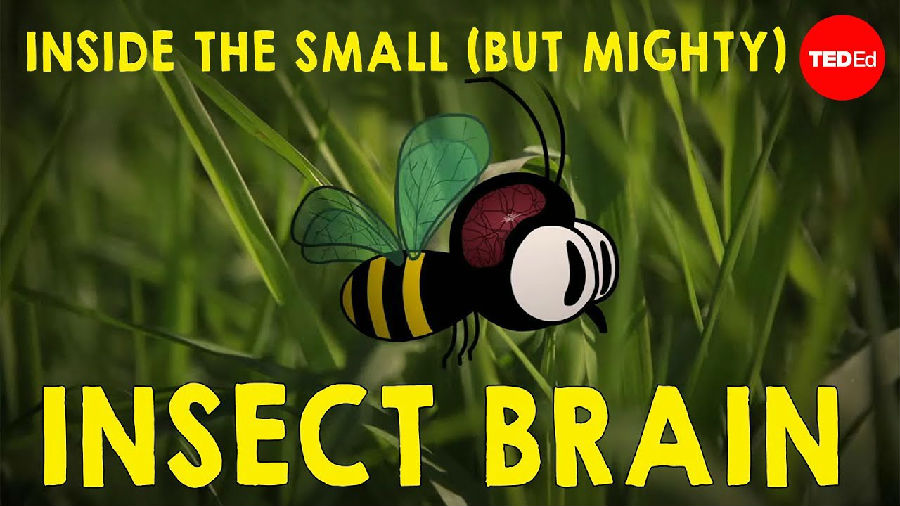(单词翻译:单击)
The human brain is one of the most sophisticated organs in the world,
人类的大脑是世界上最复杂的器官之一,
a supercomputer made of billions of neurons that processes and controls all of our senses, thoughts, and actions.
一个由数十亿神经元组成的超级计算机,控制我们所有的感观、思维和行动。
But there was something Charles Darwin found even more impressive:
但是查尔斯·达尔文发现了更引人瞩目的东西:
the brain of an ant, which he called one of the most marvelous atoms of matter in the world.
那就是蚂蚁的大脑,他称其为世界上最不可思议的原子构成物之一。
If you find it hard to believe that something so tiny could have a complex brain, you're not alone.
这么小的生物却拥有如此复杂的大脑真令人难以置信,这样想的不只你一个。
In his project to classify and describe all living things, Swedish naturalist Carl Linnaeus assumed insects had no brains at all.
瑞典自然学家卡尔·林奈在分类和描述生物时,认为昆虫根本没有大脑。
He was wrong, but understandably so.
虽然他错了,但情有可原。
Insect brains are not only miniscule, but in many respects, they function differently than our own.
昆虫的大脑不仅极其微小,而且在很多方面,与我们大脑的工作方式完全不同。
One of the most noticeable differences is that an insect that loses its head can still walk, scratch itself, breathe, and even fly.
最显而易见的区别之一就是一只没了头的昆虫仍然能够爬行、挠痒、呼吸甚至飞行。
This is because while our nervous system works like a monarchy, with the brain calling the shots,
我们神经系统的运作好比君主制,由大脑发号施令,
the insect nervous system works more like a decentralized federation.
而昆虫的神经系统却像分权制那样运行。
Many insect activities, like walking or breathing, are coordinated by clusters of neurons, also known as ganglia, along their bodies.
昆虫的许多活动,比如爬行或者呼吸,都由贯穿身体的神经元群处理,也就是神经节。
Together with the brain, these local ganglia form the insect nervous system.
各部位的神经节与大脑一起,构成了昆虫的神经系统。
While an insect can do a lot with just its local ganglia, the brain is still crucial for its survival.
尽管昆虫可以依靠神经节进行生命活动,对它的生存来说,大脑依旧不可或缺。
An insect's brain lets it perceive the world through sight and smell.
昆虫的大脑让它通过视觉和嗅觉来感知世界。
It also chooses suitable mates, remembers locations of food sources and hives,
也会让它选择合适的配偶,记住食物和巢穴的位置,
regulates communication, and even coordinates navigation over huge distances.
进行有效的沟通,甚至在长途跋涉时辨别方向。
And this vast diversity of behaviors is controlled by an organ the size of the head of a pin,
上述种种行为都由一个针尖大的器官控制,
with less than one million neurons, compared to our 86 billion.
里面的神经元不超过一百万,而我们人类,有860亿神经元。
But even though the insect brain is organized very differently from ours, there are some striking similarities.
虽然昆虫与人类大脑的组成大相径庭,但是仍有很多惊人的相似之处。
For example, most insects have smell detectors on their antennae, similar to those found in human noses.
比如说,大部分昆虫的触须都有气味感受器,与人类的鼻子功能相似。

And our primary olfactory brain regions look and function rather similarly,
并且嗅觉对应的脑区形态和功能也十分相似,
with clusters of neurons activated and deactivated in precise timing to code for specific scents.
通过精确地在特定时间激活和钝化神经元群来为气味命名。
Scientists have been astonished by these similarities because insects and humans are not very closely related.
由于昆虫和人类并非近亲,二者的相似之处让科学家十分惊奇。
In fact, our last common ancestor was a simple worm-like creature that lived more than 500 million years ago.
事实上,二者最近的共同祖先已是距今约为五百万年前一种的类似蠕虫的生物。
So how did we end up with such similar brain structures when our evolution took almost entirely different paths?
二者的进化历程自此便分道扬镳,那为什么我们还有如此相似的大脑结构呢?
Scientists call this phenomenon convergent evolution.
科学家称这种现象“趋同进化”。
It's the same principle behind birds, bats, and bees separately evolving wings.
同理,鸟类、蝙蝠和蜜蜂各自进化出了翅膀。
Similar selective pressures can cause natural selection
相似的生存压力能引起自然选择,
to favor the same evolutionary strategy in species with vastly different evolutionary pasts.
使进化历程迥然不同的物种采用同样的进化策略。
By studying the comparison between insect and human brains,
通过比较昆虫和人类的大脑,
scientists can thus understand which of our brain functions are unique, and which are general solutions to evolutionary problems.
科学家能发现哪些功能是我们的大脑独有的,哪些是生存压力的通解。
But this is not the only reason scientists are fascinated by insect brains.
但这不是科学家着迷于昆虫大脑的唯一原因。
Their small size and simplicity makes it easier to understand exactly how neurons work together in the brain.
它们小而简单,所以理解神经元的如何工作就比较容易了。
This is also valuable for engineers,
这对工程师来说也很可贵,
who study the insect brain to help design control systems for everything from self-flying airplanes to tiny search-and-rescue roach bots.
因为他们能根据昆虫大脑设计控制系统,包括无人飞机和微型搜救机器人。
So, size and complexity are not always the most impressive things.
所以,大小和复杂性不是唯一让人印象深刻的东西。
The next time you try to swat a fly,
以后你再打苍蝇,
take a moment to marvel at the efficiency of its tiny nervous system as it outsmarts your fancy brain.
先花几秒钟瞻仰一下它的神经系统,因为它比你的还好。


